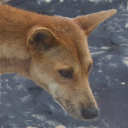Canis lupus dingo is a taxonomic rank that includes both the dingo that is native to Australia and the rare New Guinea singing dog that is native to the New Guinea Highlands. It also includes some extinct dogs that were once found in coastal Papua New Guinea and the island of Java in the Indonesian Archipelago.
The genetic evidence indicates that the dingo clade originated from East Asian domestic dogs and was introduced through the Malay Archipelago into Australia. Based on a comparison with early fossils, dingo morphology has not changed over thousands of years. This suggests that there has been no artificial selection over this period and that the dingo represents an early form of dog.
Assembly
The ASM325472v1 assembly was submitted by James Cook University on June 2018. The assembly is on scaffold level, consisting of 3,121 contigs assembled into 2,444 scaffolds. The N50 size is the length such that 50% of the assembled genome lies in blocks of the N50 size or longer. The N50 length for the contigs is 5,390,770 while the scaffold N50 is 34,446,301.
Gene annotation
The gene annotation process was carried out using a combination of protein-to-genome alignments, annotation mapping from a suitable reference species and RNA-seq alignments (where RNA-seq data with appropriate meta data were publicly available). For each candidate gene region, a selection process was applied to choose the most appropriate set of transcripts based on evolutionary distance, experimental evidence for the source data and quality of the alignments. Small ncRNAs were obtained using a combination of BLAST and Infernal/RNAfold. Pseudogenes were calculated by looking at genes with a large percentage of non-biological introns (introns of <10bp), where the gene was covered in repeats, or where the gene was single exon and evidence of a functional multi-exon paralog was found elsewhere in the genome. lincRNAs were generated via RNA-seq data where no evidence of protein homology or protein domains could be found in the transcript.
In accordance with the Fort Lauderdale Agreement, please check the publication status of the genome/assembly before publishing any genome-wide analyses using these data.
More information
General information about this species can be found in Wikipedia.
Statistics
Summary
| Assembly | ASM325472v1, INSDC Assembly GCA_003254725.1, Jun 2018 |
| Base Pairs | 2,439,831,507 |
| Golden Path Length | 2,439,831,507 |
| Annotation provider | Ensembl |
| Annotation method | Full genebuild |
| Genebuild started | Sep 2018 |
| Genebuild released | Dec 2018 |
| Genebuild last updated/patched | Mar 2020 |
| Database version | 115.1 |
Gene counts
| Coding genes | 21,360 |
| Non coding genes | 4,713 |
| Small non coding genes | 3,002 |
| Long non coding genes | 1,120 |
| Misc non coding genes | 591 |
| Pseudogenes | 484 |
| Gene transcripts | 40,056 |
Other
| Genscan gene predictions | 50,279 |
